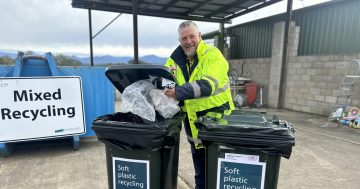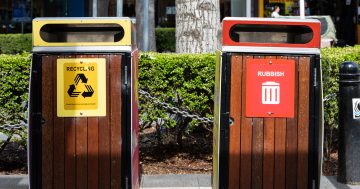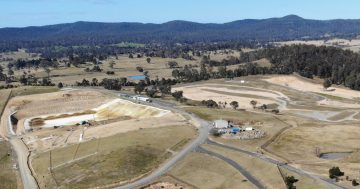
The Hume upgrade aims to eliminate mixed plastics as a waste stream in the ACT. Photo: File.
Less of the Canberra region’s paper and plastic rubbish will be going to waste thanks to a $21 million technology boost to the Hume recycling facility announced today.
The joint Commonwealth and ACT Government funding is part of the Australian Government’s $190 million Recycling Modernisation Fund, set up to expand the nation’s recycling capacity in preparation for the waste export bans that come into force next year.
Upgrades to the ACT Materials Recovery Facility will mean better separation of waste and less contamination.
They include optical scanning equipment to identify and separate different types of plastics and better screening technology to reduce contamination in paper and cardboard recycling.
Glass washing facilities will also provide better quality crushed glass ‘sand’ products that can be used in a wider range of products, including construction and road making.
Plastic washing and ‘flaking’ facilities will break washed plastic into their different polymers providing a clean product to use in making other plastic products.
ACT Minister for Recycling and Waste Reduction Chris Steel said that governments were stepping up to take responsibility for waste and its impact on the environment, with investment in the latest technology to generate cleaner recycling in the ACT and the Canberra Region.
“When Canberrans put material in their yellow bin they should trust that it is sorted and processed locally so that it has as much value as possible for re-use and remanufacturing,” Minister Steel said.
“These upgrades to our Materials Recovery Facility will deliver better separation of recycling streams such as paper, glass and plastic, reducing contamination rates and providing better quality recycled material.
“This is the local waste processing infrastructure that our region needs to be ready for the waste export ban, and so that we can effectively eliminate mixed plastics as a waste stream in the ACT.”
Mr Steel said the new tech at Hume meant the ACT could continue with its three bins approach, rather than have separate bins for plastic and paper and cardboard as is the case in other jurisdictions such as Victoria.
The upgrades will prepare the Hume MRF for the export bans decided by the Council of Australian Governments on unprocessed glass from January 2021 and plastics by July 2021.
”This will help us achieve that in the ACT and contribute also to the better and cleaner recycling streams in the region,” Mr Steel told the ABC.
The Hume facility receives ‘yellow bin’ co-mingled recyclable waste from ACT household collections, six ACT Regional Drop-Off Centres, commercial operators and material from five regional councils – Queanbeyan-Palerang Regional Council, Snowy Mountains Council, Yass Valley Regional Council, Bega Valley Shire Council and Upper Lachlan Shire Council.
It also receives material from the ACT’s and surrounding councils’ Container Deposit Scheme (CDS) network for baling, verifying and selling to the commodity market.
Federal Minister for the Environment Sussan Ley joined Mr Steel at Hume to announce the partnership and said the upgrade would create a higher quality recycled product that adds value and reduces the amount of waste ending up in landfill.
“Our Recycling Modernisation Fund is turning waste into a product of value. No longer are we going to see rubbish as a problem that needs to be solved or put into the ground but as an important resource,” Ms Ley said.
“The upgraded facility will have the capacity to improve the quality and marketability of 23,000 tonnes of paper and mixed cardboard, 1,800 tonnes of mixed plastics and 14,000 tonnes of glass from the ACT and five regional NSW councils annually.”
She said the deal would also create around 100 direct and indirect jobs for the ACT and surrounding region, boosting local economies.
The Recycling Modernisation Fund aims to unlock $600 million of recycling investment and drive a billion-dollar transformation of Australia’s waste and recycling capacity.
The move to expand Australian recycling was sparked by the 2018 Chinese ban on importing waste and increasing concern at where Australian waste was ending up.
Original Article published by Ian Bushnell on The RiotACT.













